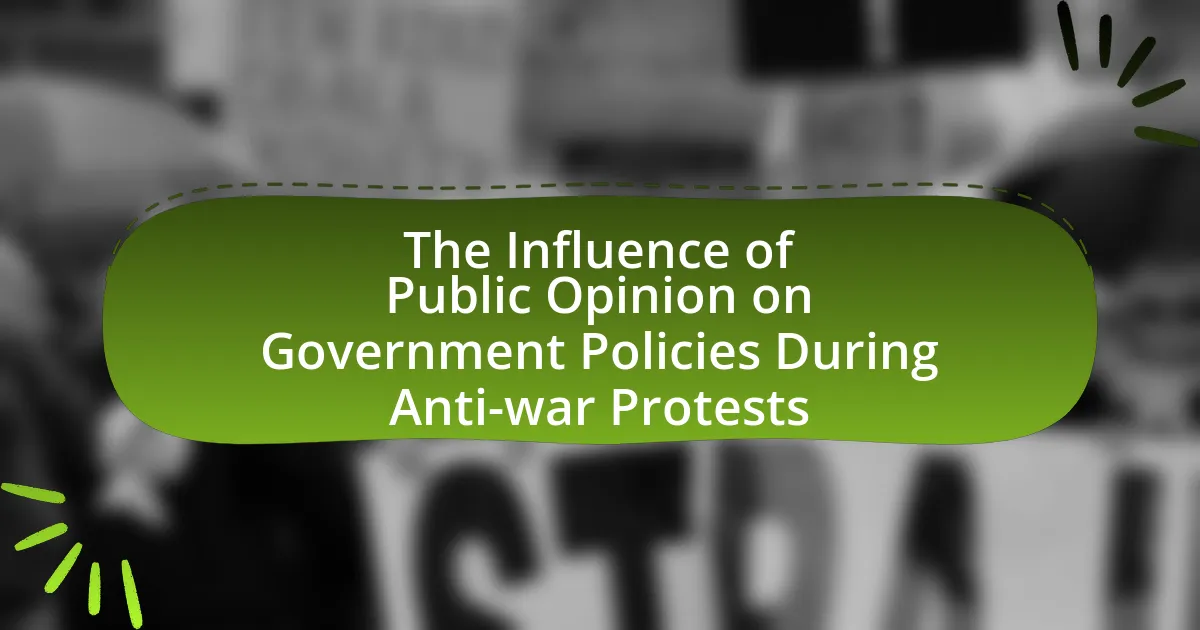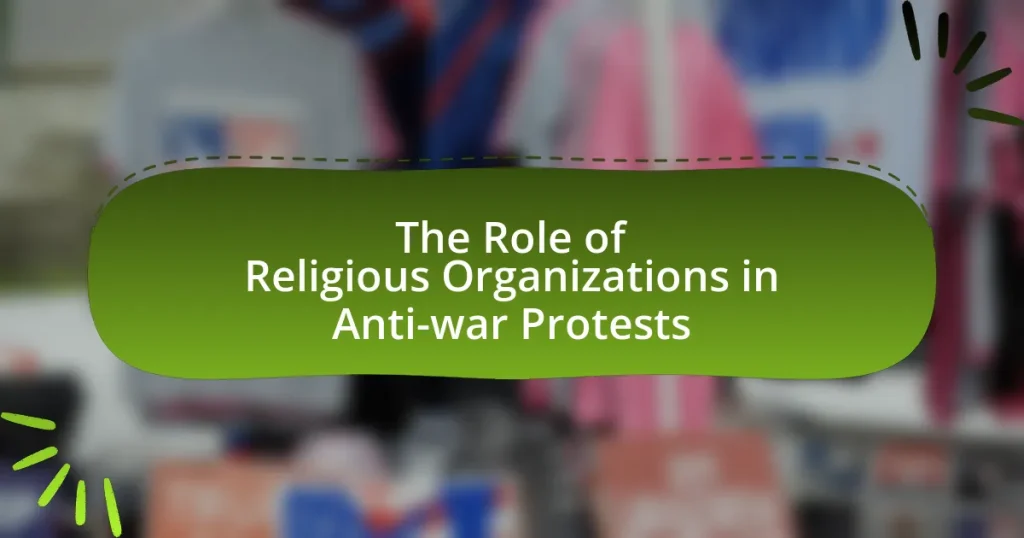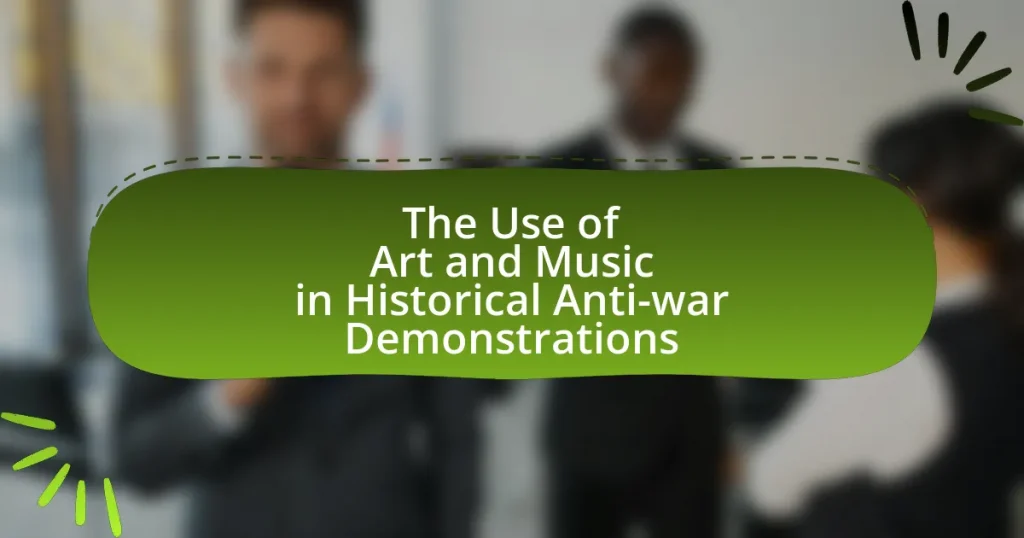The article examines the influence of public opinion on government policies during anti-war protests, highlighting how widespread dissent can compel policymakers to reconsider military strategies. It discusses the mechanisms through which public sentiment shapes government responses, including media portrayals, grassroots activism, and social media’s role in mobilizing support. Historical examples, such as the Vietnam War and the Iraq War, illustrate the correlation between public opinion and policy changes, emphasizing the importance of opinion polls and public consultations in shaping government actions. The article also outlines strategies activists can adopt to effectively influence public perception and drive policy change.
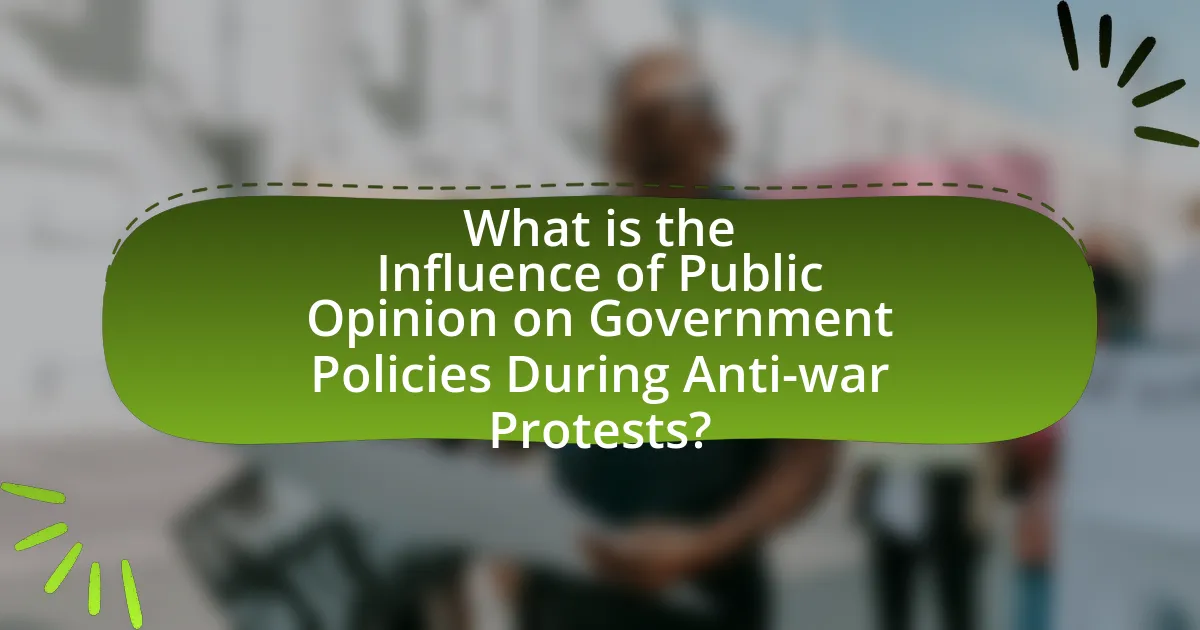
What is the Influence of Public Opinion on Government Policies During Anti-war Protests?
Public opinion significantly influences government policies during anti-war protests by shaping political discourse and pressuring decision-makers. When large segments of the population express opposition to military actions, as seen during the Vietnam War, policymakers often respond to maintain public support and electoral viability. For instance, the widespread protests in the 1960s and 1970s led to a shift in U.S. policy, culminating in the withdrawal of troops from Vietnam. This demonstrates that sustained public dissent can compel governments to reconsider their military strategies and prioritize diplomatic solutions over conflict.
How does public opinion shape government responses to anti-war protests?
Public opinion significantly shapes government responses to anti-war protests by influencing policymakers’ perceptions of public sentiment and electoral viability. When a substantial portion of the population expresses opposition to a war through protests, governments often feel pressured to respond in ways that align with public sentiment to maintain legitimacy and avoid political backlash. For instance, during the Vietnam War, widespread anti-war protests led to a shift in U.S. policy, culminating in the eventual withdrawal of troops as public discontent grew. This correlation between public opinion and government action is further evidenced by polling data indicating that high levels of disapproval for military engagements often result in decreased support for the ruling party in elections, compelling governments to reconsider their military strategies and engage in dialogue with protestors.
What factors contribute to the formation of public opinion during anti-war movements?
The formation of public opinion during anti-war movements is primarily influenced by media coverage, grassroots activism, and political leadership. Media coverage shapes perceptions by framing the narrative around the war, highlighting casualties, and showcasing protests, which can sway public sentiment. Grassroots activism mobilizes communities, fostering discussions and creating networks that amplify dissenting voices. Political leadership also plays a crucial role; leaders who oppose the war can legitimize anti-war sentiments and encourage public discourse. Historical examples, such as the Vietnam War protests in the 1960s, illustrate how these factors combined to shift public opinion significantly against the war, ultimately influencing government policies.
How do media portrayals affect public perception of anti-war protests?
Media portrayals significantly shape public perception of anti-war protests by framing the narrative around these events. When media outlets emphasize peaceful demonstrations and articulate the protesters’ messages, public support for the protests tends to increase, as seen during the Vietnam War era when extensive coverage of anti-war sentiments contributed to growing opposition to the conflict. Conversely, if media coverage focuses on violence or disruptions associated with protests, it can lead to negative perceptions, diminishing public sympathy and support. Research by the Pew Research Center indicates that media framing can influence public attitudes, with 60% of respondents stating that how news is reported affects their views on social movements. Thus, the way media presents anti-war protests plays a crucial role in shaping societal attitudes and, consequently, influencing government policy responses.
Why are anti-war protests significant in influencing government policies?
Anti-war protests are significant in influencing government policies because they mobilize public opinion against military actions, compelling policymakers to reconsider their strategies. Historical examples, such as the Vietnam War protests in the 1960s and 1970s, demonstrate that widespread public dissent can lead to shifts in government decisions, as seen when the U.S. government eventually withdrew troops in response to growing anti-war sentiment. Additionally, studies indicate that sustained protests can impact electoral outcomes, pressuring elected officials to align with constituents’ views on war, thereby reinforcing the connection between public activism and policy change.
What historical examples illustrate the impact of public opinion on war-related policies?
Public opinion has significantly influenced war-related policies throughout history, with notable examples including the Vietnam War and the Iraq War. During the Vietnam War, widespread protests and public dissent in the United States led to a shift in government policy, culminating in the decision to withdraw troops in 1973. The Tet Offensive in 1968, which contradicted official government claims of progress, fueled anti-war sentiment and eroded public trust, ultimately pressuring policymakers to reconsider their military strategy. Similarly, in the lead-up to the Iraq War in 2003, public opinion turned against the invasion as evidence of weapons of mass destruction was questioned. This skepticism was reflected in protests and declining approval ratings for the Bush administration, influencing the administration’s approach to military engagement and post-war planning. These examples demonstrate how public sentiment can directly impact government decisions regarding military actions and policies.
How do grassroots movements mobilize public opinion against government actions?
Grassroots movements mobilize public opinion against government actions by leveraging community engagement, social media, and organized protests to raise awareness and create a collective voice. These movements often utilize local networks to disseminate information, organize events, and foster discussions that highlight perceived injustices or government overreach. For example, during the Vietnam War, grassroots organizations like Students for a Democratic Society effectively mobilized public sentiment through campus protests and teach-ins, significantly influencing public opinion and ultimately government policy. This historical context illustrates how grassroots efforts can shift public perception and pressure governments to reconsider their actions.

What role does social media play in shaping public opinion during anti-war protests?
Social media significantly shapes public opinion during anti-war protests by facilitating rapid information dissemination and enabling grassroots mobilization. Platforms like Twitter and Facebook allow activists to share real-time updates, organize events, and amplify their messages, which can lead to increased public awareness and engagement. For instance, the Arab Spring demonstrated how social media was instrumental in mobilizing protests against authoritarian regimes, influencing global perceptions of those movements. Research by the Pew Research Center indicates that 64% of Americans believe social media has a major impact on political activism, highlighting its role in shaping opinions and driving collective action during anti-war protests.
How has social media changed the landscape of anti-war activism?
Social media has significantly transformed anti-war activism by enabling rapid information dissemination and fostering global connectivity among activists. Platforms like Twitter and Facebook allow for real-time updates, mobilization of protests, and the sharing of diverse perspectives, which amplifies the reach and impact of anti-war messages. For instance, during the Iraq War, social media campaigns helped organize large-scale protests and brought attention to civilian casualties, influencing public opinion and, subsequently, government policies. Research by the Pew Research Center indicates that social media has become a primary source of news for many individuals, further shaping public discourse around war and peace.
What are the advantages of using social media for organizing protests?
Using social media for organizing protests offers significant advantages, including rapid information dissemination, increased reach, and enhanced mobilization. Social media platforms allow organizers to quickly share event details, updates, and calls to action, reaching a broad audience almost instantaneously. For instance, during the Arab Spring, social media played a crucial role in mobilizing protests across multiple countries, demonstrating its effectiveness in rallying support and coordinating actions. Furthermore, social media enables diverse groups to connect and collaborate, fostering a sense of community and shared purpose among participants, which can amplify the impact of the protest.
How do online platforms amplify voices against war?
Online platforms amplify voices against war by providing accessible channels for individuals and groups to share their perspectives, mobilize support, and disseminate information rapidly. These platforms, such as social media, enable users to reach a global audience, facilitating the spread of anti-war messages and fostering community engagement. For instance, during the Iraq War, platforms like Twitter and Facebook were instrumental in organizing protests and sharing real-time updates, which significantly influenced public opinion and, subsequently, government policies. Research indicates that social media campaigns can increase awareness and participation in anti-war movements, demonstrating their effectiveness in shaping discourse and mobilizing action against military conflicts.
What challenges do activists face in influencing public opinion through social media?
Activists face significant challenges in influencing public opinion through social media, primarily due to misinformation, algorithm biases, and the saturation of content. Misinformation can undermine credible messages, as false narratives often spread faster than accurate information, leading to public confusion. Algorithm biases on platforms like Facebook and Twitter can limit the visibility of activist content, favoring sensational or polarizing posts over nuanced discussions. Additionally, the sheer volume of content on social media creates a competitive environment where important messages can be easily overlooked. According to a 2021 study by the Pew Research Center, 64% of Americans believe that misinformation has a major impact on public opinion, highlighting the difficulty activists face in ensuring their messages are heard and understood amidst the noise.
How do misinformation and disinformation campaigns affect public perception?
Misinformation and disinformation campaigns significantly distort public perception by spreading false or misleading information, which can lead to confusion and mistrust among the populace. For instance, during the COVID-19 pandemic, studies indicated that misinformation about the virus’s origins and treatment options contributed to public hesitancy regarding vaccines, as reported by the World Health Organization. This manipulation of information can sway public opinion, ultimately influencing government policies, as seen in the response to anti-war protests where distorted narratives about the reasons for conflict can alter public support or opposition.
What strategies can activists use to counteract negative narratives?
Activists can counteract negative narratives by employing strategies such as reframing the conversation, utilizing social media effectively, and building coalitions with diverse groups. Reframing involves presenting issues in a way that highlights positive aspects or alternative perspectives, which can shift public perception. For instance, during anti-war protests, activists have successfully reframed military actions as detrimental to both national and global stability, thereby garnering broader support.
Effective use of social media allows activists to disseminate their messages rapidly and engage directly with the public, countering misinformation in real-time. Research indicates that social media campaigns can significantly influence public opinion, as seen in the Arab Spring, where online activism played a crucial role in shaping narratives against oppressive regimes.
Building coalitions with various organizations enhances credibility and amplifies voices, making it harder for negative narratives to dominate. Collaborative efforts can unify diverse demographics, creating a stronger front against misinformation. For example, the Women’s March in 2017 brought together various groups to advocate for women’s rights, effectively countering negative portrayals of the movement.
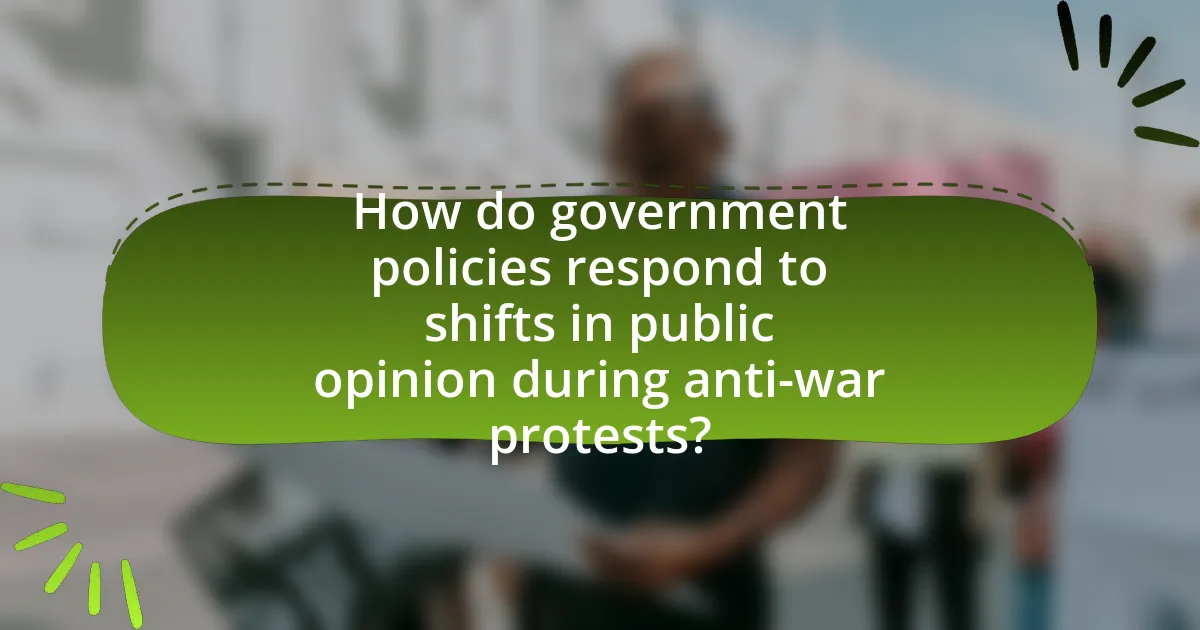
How do government policies respond to shifts in public opinion during anti-war protests?
Government policies often shift in response to changes in public opinion during anti-war protests by adjusting military strategies, reallocating funding, or initiating diplomatic negotiations. For instance, during the Vietnam War, widespread protests led the U.S. government to gradually withdraw troops and eventually seek a peace agreement, reflecting the growing public discontent. This response is evidenced by the 1969 Moratorium to End the War in Vietnam, which saw millions participating, prompting policymakers to reconsider their approach. Such actions demonstrate that government decisions are influenced by the need to align with public sentiment to maintain legitimacy and support.
What mechanisms do governments use to gauge public sentiment on war?
Governments use various mechanisms to gauge public sentiment on war, including opinion polls, social media analysis, and public consultations. Opinion polls, conducted by organizations like Gallup and Pew Research, provide quantitative data on public attitudes towards military actions, revealing trends and shifts in sentiment over time. Social media analysis leverages algorithms to track discussions and sentiments expressed on platforms like Twitter and Facebook, offering real-time insights into public opinion. Public consultations, such as town hall meetings or forums, allow citizens to voice their opinions directly to policymakers, facilitating a more qualitative understanding of public sentiment. These mechanisms collectively inform government decisions and policies regarding military engagement, reflecting the influence of public opinion during anti-war protests.
How do opinion polls influence policy decisions during conflicts?
Opinion polls significantly influence policy decisions during conflicts by providing governments with insights into public sentiment, which can shape their strategic choices. For instance, when a majority of the population expresses opposition to military action, policymakers may reconsider or alter their approach to avoid political backlash and maintain public support. Historical examples include the Vietnam War, where rising anti-war sentiment reflected in opinion polls led to a shift in U.S. policy, ultimately resulting in troop withdrawals. Additionally, studies show that leaders often prioritize public opinion data to gauge the potential electoral consequences of their decisions, reinforcing the impact of opinion polls on conflict-related policies.
What role do public consultations play in shaping government responses?
Public consultations play a crucial role in shaping government responses by providing a platform for citizens to express their opinions and influence policy decisions. These consultations allow governments to gauge public sentiment, identify key concerns, and incorporate feedback into their strategies. For instance, during anti-war protests, public consultations can reveal widespread opposition to military actions, prompting governments to reconsider their policies or adopt alternative approaches. Research indicates that when governments actively engage with public input, they are more likely to align their responses with the values and priorities of their constituents, thereby enhancing democratic legitimacy and accountability.
How can public opinion lead to policy changes in wartime contexts?
Public opinion can lead to policy changes in wartime contexts by exerting pressure on government officials to respond to the sentiments of the populace. For instance, during the Vietnam War, widespread anti-war protests significantly influenced U.S. policy, leading to a gradual withdrawal of troops as public discontent grew. Polling data from that era indicated that as opposition to the war increased, political leaders faced mounting pressure to alter their strategies, demonstrating a direct correlation between public sentiment and policy adjustments.
What are the steps involved in translating public dissent into policy action?
The steps involved in translating public dissent into policy action include mobilization, agenda-setting, policy formulation, advocacy, and implementation. Mobilization occurs when citizens organize and express their dissent through protests or campaigns, as seen during the Vietnam War protests in the 1960s, which significantly influenced public discourse. Agenda-setting follows, where the concerns raised by the public gain attention from policymakers and media, leading to discussions in legislative bodies. Next, policy formulation involves drafting specific proposals that address the public’s concerns, often influenced by advocacy groups that represent dissenting voices. Advocacy plays a crucial role in lobbying decision-makers to support these proposals, exemplified by organizations like the American Civil Liberties Union during anti-war movements. Finally, implementation occurs when the proposed policies are enacted and enforced, reflecting the initial public dissent that sparked the entire process. Each step is interconnected, demonstrating how public dissent can effectively lead to tangible policy changes.
How do elected officials respond to constituents’ anti-war sentiments?
Elected officials typically respond to constituents’ anti-war sentiments by adjusting their public statements, policy positions, and legislative actions to align with the expressed concerns of their constituents. For instance, during the Vietnam War, many politicians shifted their stance on military involvement in response to widespread anti-war protests, reflecting the growing public opposition. This responsiveness is often driven by the need to maintain electoral support, as evidenced by surveys indicating that politicians who align with their constituents’ views on contentious issues, such as war, are more likely to secure votes in subsequent elections.
What best practices can activists adopt to effectively influence public opinion?
Activists can effectively influence public opinion by utilizing strategic communication, grassroots mobilization, and coalition-building. Strategic communication involves crafting clear, compelling messages that resonate with the target audience, often supported by data and personal stories to enhance relatability. Grassroots mobilization encourages community engagement through events, social media campaigns, and direct outreach, fostering a sense of collective action. Coalition-building with other organizations amplifies voices and resources, creating a broader platform for advocacy. Research indicates that movements with strong grassroots support and effective messaging can significantly shift public perceptions, as seen in the anti-war protests of the 1960s, where widespread public dissent influenced government policy decisions.
